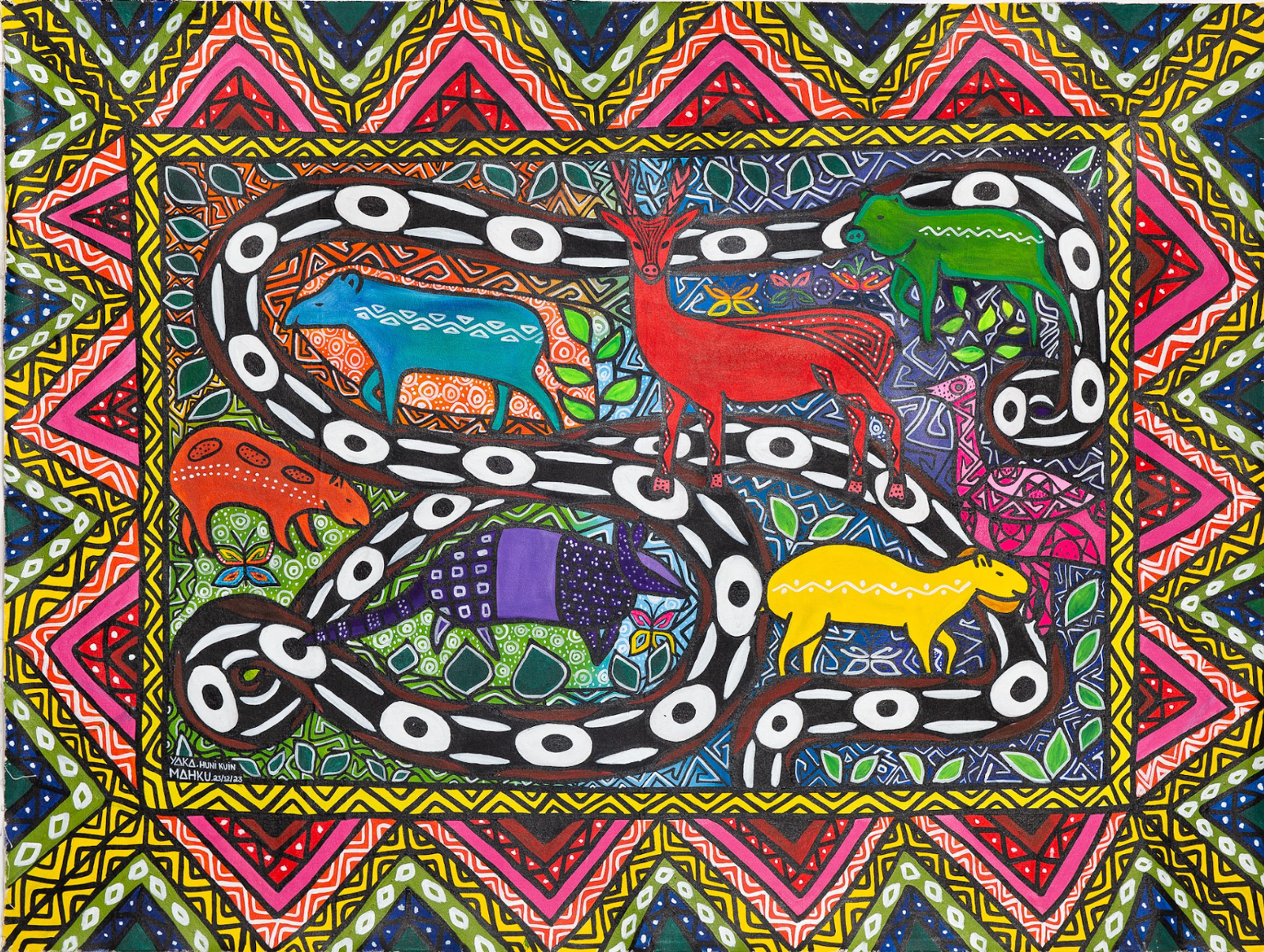By weaving together the legacies of Brazilian modernism with the practices of contemporary Afro-Brazilian and Indigenous artists, the exhibition confronts the silences of history while underscoring how these communities are no longer passive subjects of appropriation, but active agents of narrative and transformation. Figures such as Denilson Baniwa, Jaider Esbell, and Nádia Taquary reclaim modernist strategies, most notably Antropofagia, subverting them to affirm sovereignty, memory, and cultural continuity.
in this article edition, we move beyond the curatorial framework to examine how these artists are positioning themselves within the global art market. From institutional acquisitions to appearances at international biennials and major exhibitions, from auction benchmarks to critical recognition, we offer a broader perspective for collectors and investors who may be encountering Brazilian art in a new light.
Modernism
Tarsila do Amaral
Tarsila do Amaral (1886–1973) was a pioneer of Brazilian modernism whose work fused national cultural heritage with European avant-garde influences, marked by a distinctive blend of Cubist and Surrealist elements. She played a central role in the Pau-Brasil movement, which promoted a nationalist and original art rooted in the colors, forms, and themes of Brazil, thereby reinforcing the idea of an independent Brazilian modernism. In 1928, she collaborated closely with Oswald de Andrade in formulating the Manifesto of Anthropophagy, which proposed “digesting” foreign influences to create a truly Brazilian artistic language.
One of her most iconic works, A Negra (originally painted in 1923, with a later version from 1940), is presented in the exhibition. Considered a precursor to the Anthropophagic movement, the painting elevates the Afro-Brazilian figure as a monumental subject, restoring long-denied dignity and affirming its essential role in the cultural construction of Brazil—breaking away from colonial representations. The work portrays a stylized Black woman, rendered with geometric forms and a flattened composition, merging European modernist techniques with Brazil’s central cultural questions to assert a vision of art that assimilates the external and transforms it into something original.
Her masterpiece Abaporu, 1928, acquired by Museo de Arte Latinoamericano de Buenos Aires (MALBA) in 1995 at a Christie’s auction for $1.35 million, a groundbreaking price at the time, has since become the museum’s emblem in Buenos Aires, drawing visitors from around the globe. Other landmark works include Lua, acquired by Museum of Modern Art in New York in 2019 for $20 million, and A Caipirinha, which sold for $12 million (R$57 million) at auction at the Bolsa de Arte in 2020.
In 2025, Tarsila’s work continues to shape the international art scene, notably through the exhibition Tarsila do Amaral: Painting Modern Brazil, presented at both the Musée du Luxembourg in Paris and the Guggenheim Bilbao. Currently, only three of her works are housed in European museums: A Cuca at the Musée de Grenoble, one painting at the Museo Reina Sofía in Madrid, and another at the Hermitage Museum in Russia. The rest of her oeuvre remains in private collections in Brazil.

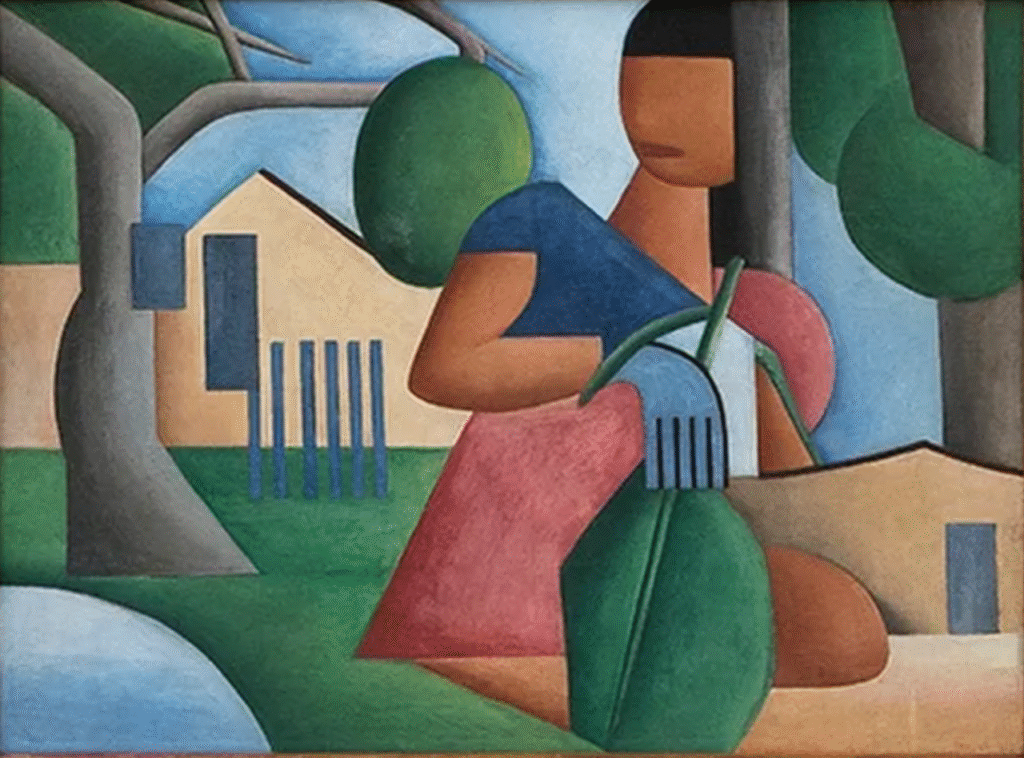
Maria Martins
Maria Martins (Campanha, MG, 1894 – Rio de Janeiro, 1973) was one of the most important sculptors of international modernism, celebrated for her contributions to surrealism. Married to diplomat Carlos Martins, she lived between Brazil, the United States, and France, forming close ties with André Breton, Marcel Duchamp, and Piet Mondrian. After studying sculpture in Belgium, she dedicated herself fully to art in 1939, studying with Jacques Lipchitz and Stanley William Hayter in Washington, D.C., while exploring her Brazilian roots through bronze. In 1946, she debuted at the Valentine Gallery in New York alongside Mondrian, achieving critical and commercial success. That same year, she acquired Mondrian’s Broadway Boogie Woogie, later donated to MoMA, where it remains a landmark of modern art.
During her years in the United States, Maria Martins maintained a close relationship with Marcel Duchamp, who portrayed her in his final work Étant donnés, 1966. She provided casting instructions, served as his model, and inspired his representation of the female body. Her celebrated sculpture O Impossível, 1946–48, a metaphor of desire and separation shaped by her conflicted bond with Duchamp, entered the collection of MALBA, Buenos Aires, in 2001. Martins also redefined surrealism by incorporating Amazonian myths, transforming its European matrix into a tool of cultural affirmation. Works such as Canto do mar, 1952 evoke the vital impulse of ancestral memory, fusing indigenous cosmologies with the sensuality of tropical imagery, and positioning her as a sculptor who projected Brazilian mythology into the international modernist imagination.
In 2024, Martins participated in the 60th Venice Biennale with However, 1948, in the central exhibition Foreigners Everywhere, curated by Adriano Pedrosa, which brought together 331 artists from diverse backgrounds and approaches. Her work was also featured in the retrospective Maria Martins: Ficcções Tropicais, held by the São Paulo Museum of Art (MASP), which presented 45 sculptures and engravings produced in the 1940s and 1950s, as well as 41 publications and photographs.
In 2025, the sculpture O Guerreiro, created in 1949 by Martins and measuring 47.5 by 31.4 by 5.6 cm, was auctioned by Sotheby’s in the sale Collection Niomar Moniz Sodré Bittencourt | La Liberté pour dogme, reaching a value of €279.400. In the private market, her bronze works, depending on their size, usually fetch between $200.000 and $15 million.
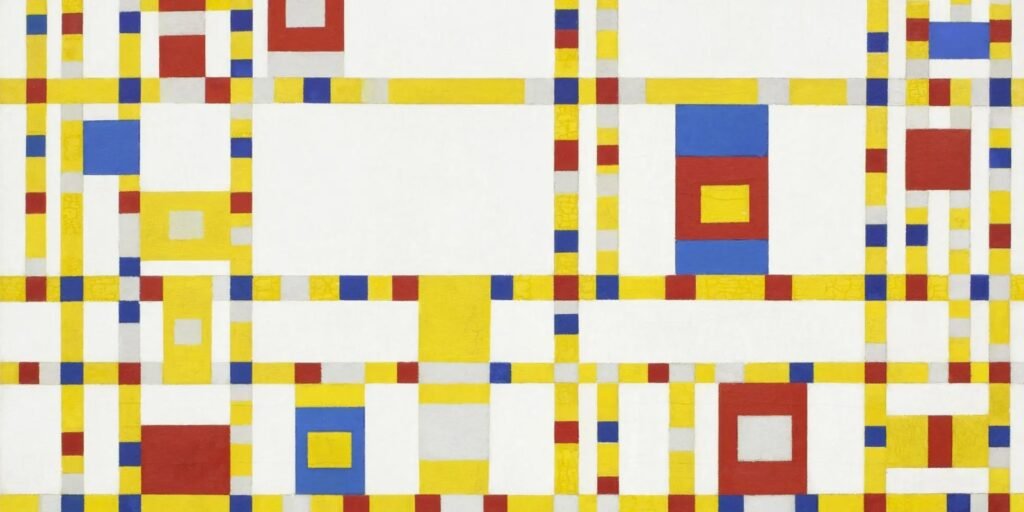
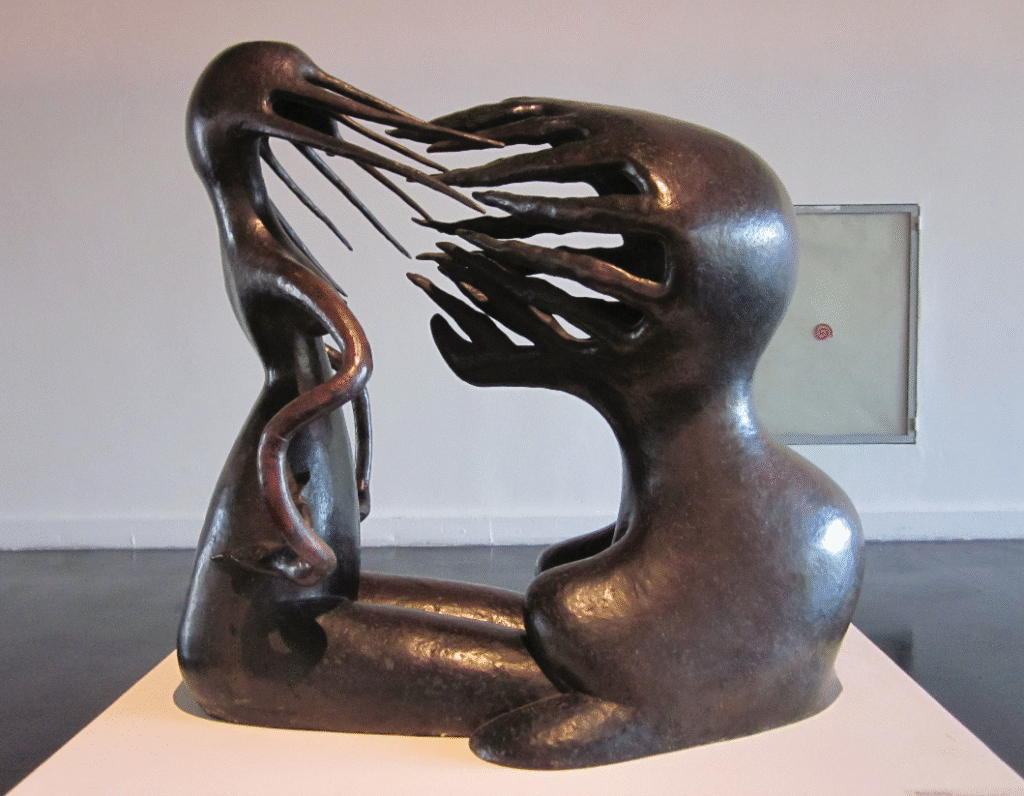
Vicente do Rego Monteiro
Vicente do Rego Monteiro (Recife, 1899 – 1970) was a painter, sculptor, poet, and teacher, recognized as a central figure of Brazilian modernism. Trained at the Académie Julian in Paris (1911–1914), he returned to Brazil to exhibit in São Paulo in 1920 and later took part in the 1922 Week of Modern Art. His work blends European modernist influences with Indigenous motifs, particularly Marajoara designs, visible in his illustrations for P. L. Duchartre’s Légendes, Croyances et Talismans des Indiens de l’Amazonie and in the masks and costumes for the ballet Légendes Indiennes de l’Amazonie, 1923. After a long stay in Paris, he returned to Brazil in 1930, bringing the École de Paris exhibition, which included works by Picasso, Braque, Miró, Severini, and Léger, to Recife, Rio de Janeiro, and São Paulo, marking a decisive cultural exchange. He later taught at the Ginásio Pernambucano, the Recife School of Fine Arts, and the Central Institute of Arts in Brasília.
In 2018, the Centre Georges Pompidou in Paris presented a selection of works by Paulo Bruscky as part of the project L’œil écoute, which explores modern art through a dialogue between the museum’s permanent collection and invited artists. Displayed alongside rare works by Vicente do Rego Monteiro which is part of the Centre Pompidou permanent collection, the exhibition highlighted the affinity between the two artists, emphasizing their humor, sensitivity, and experimental spirit, which connect different generations of Brazilian art to major international figures.
Recently, his work O Urso, 1925 was acquired by the MALBA. This painting depicts a small animal using a palette of ochres and browns inspired by Amazonian ceramics, combining faceted volumes with Cubist and Futurist forms. The work reflects the artist’s pursuit of a modern Brazilian identity, blending influences from indigenous art and European modernism.
His works are represented in some of the most prestigious Brazilian collections, including the Museu de Arte de São Paulo Assis Chateaubriand (MASP), the Museu Nacional de Belas Artes (MNBA) in Rio de Janeiro, and the Museu de Arte Contemporânea da Universidade de São Paulo (MAC/USP). She is also part of the renowned Gilberto Chateaubriand Collection at the Museu de Arte Moderna do Rio de Janeiro (MAM RJ), in addition to the collection of the Banco Central do Brasil in Brasília.
On the international scene, her work has been acquired by major institutions such as the Musée National d’Art Moderne – Centre Georges Pompidou in Paris and The Metropolitan Museum of Art in New York, confirming her place within the global canon of modern and contemporary art.
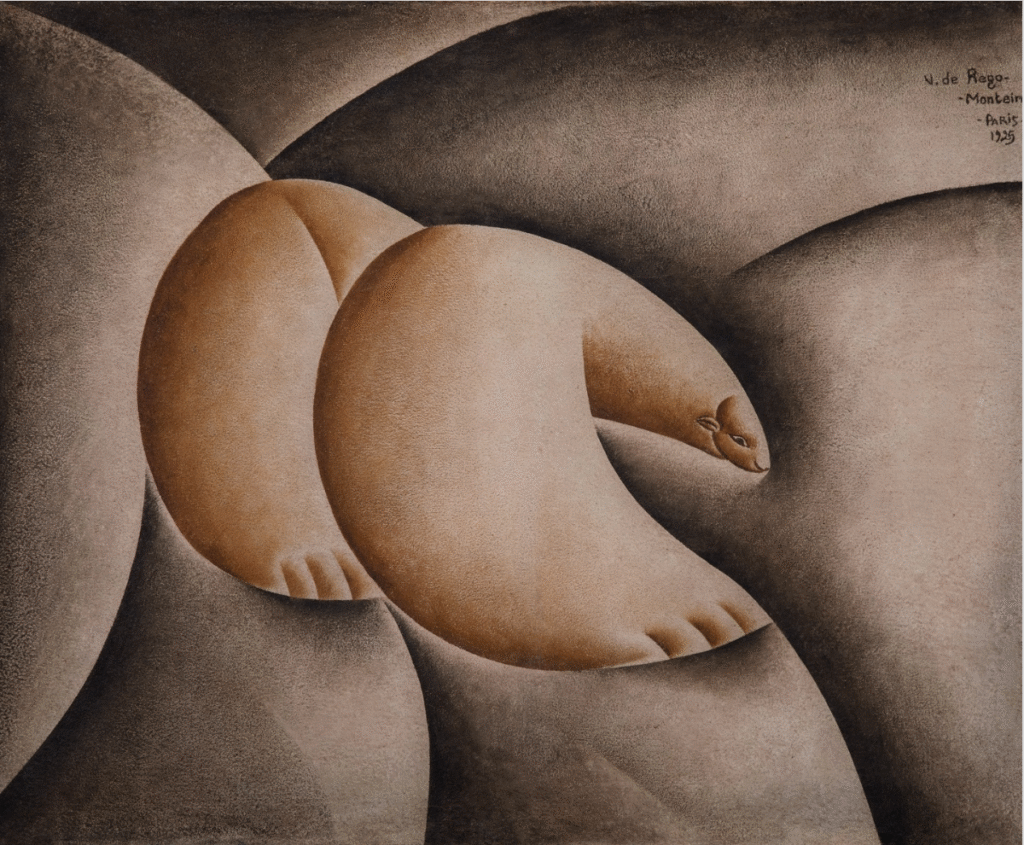
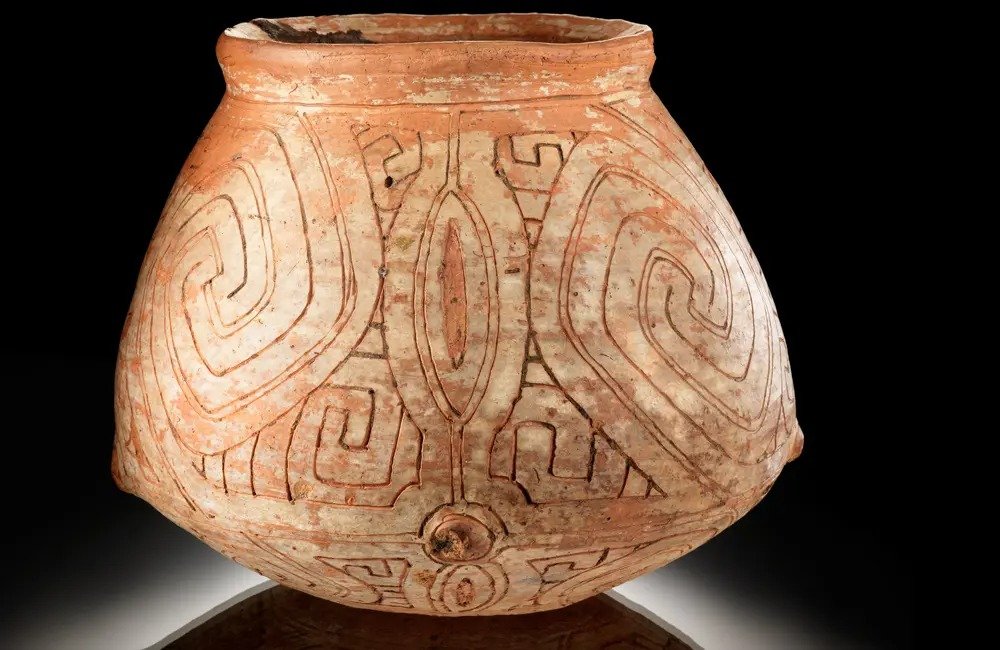
Glauco Rodrigues
Glauco Rodrigues (Bagé, 1929 – Rio de Janeiro, 2004) was a central figure of 20th-century Brazilian art, known for his critical reflection on the country’s cultural roots. Self-taught until 1949, he studied at the National School of Fine Arts in Rio de Janeiro and soon co-founded the Bagé and Porto Alegre Engraving Clubs with artists such as Carlos Scliar and Danúbio Gonçalves. His work draws on folklore, popular religiosity, tropical fruits, and everyday life, rendered in vibrant colors and compositions that shift between figuration and abstraction. Awarded at the IX National Salon of Modern Art in 1960, he traveled to Europe, living in Paris and Rome, and exhibiting at the Paris and Venice Biennales, which consolidated his international career. Works such as Pau-Brasil, 1974 reveal his pop and ironic approach, exposing the contradictions of national symbols and interrogating the colonial legacies embedded in Brazilian identity.
In 2019, Danielian Gallery inaugurated a major exhibition dedicated to him and, in the same year, Rodrigues was honored with a Special Room at the Istanbul Biennial, 2019, curated by Nicolas Bourriaud. Bourriaud, who had already presented an important selection of Rodrigues’ works at L’Ange de l’Histoire at the École des Beaux-Arts in Paris, 2012, recognized him as a pioneering and original voice, an artist who, decades ahead of his time, anticipated many of the methods and directions of contemporary art. Rodrigues also participated in the 32nd Biennale di Venezia in 1964, further consolidating his international recognition. In 2021, Bergamin & Co. presented the exhibition Glauco Rodrigues: Acontece que somos canibais, accompanied by striking installation views that highlighted the artist’s playful yet critical exploration of Brazilian identity.
Glauco Rodrigues passed away in 2004, leaving behind a legacy that continues to influence generations of Brazilian artists, especially through the way he translated the richness and complexity of Brazilian culture into colors and shapes. On the private market, his works are highly valued, selling for between $10.000 and $200.000, reflecting the importance and recognition of his artistic production.
His works are part of important public collections in Brazil and abroad, including the São Paulo Museum of Modern Art (MAM-SP), the Museu de Arte Moderna do Rio de Janeiro (MAM-RJ), the Museu de Arte do Rio Grande do Sul (MARGS), and the Museu Victor Meirelles. Internationally, his works are held by the University of Essex in the United Kingdom, the Museo de Bellas Artes de La Coruña in Spain, and the Essex Collection of Art from Latin America, which houses Saint Sebastian in June by Glauco Rodrigues. In addition to collection holdings, Rodrigues also produced public or site-integrated works, including a mosaic panel installed at the entrance of the Fundação Oswaldo Cruz (Fiocruz), Rio de Janeiro, created for the institution’s centennial around 2000.
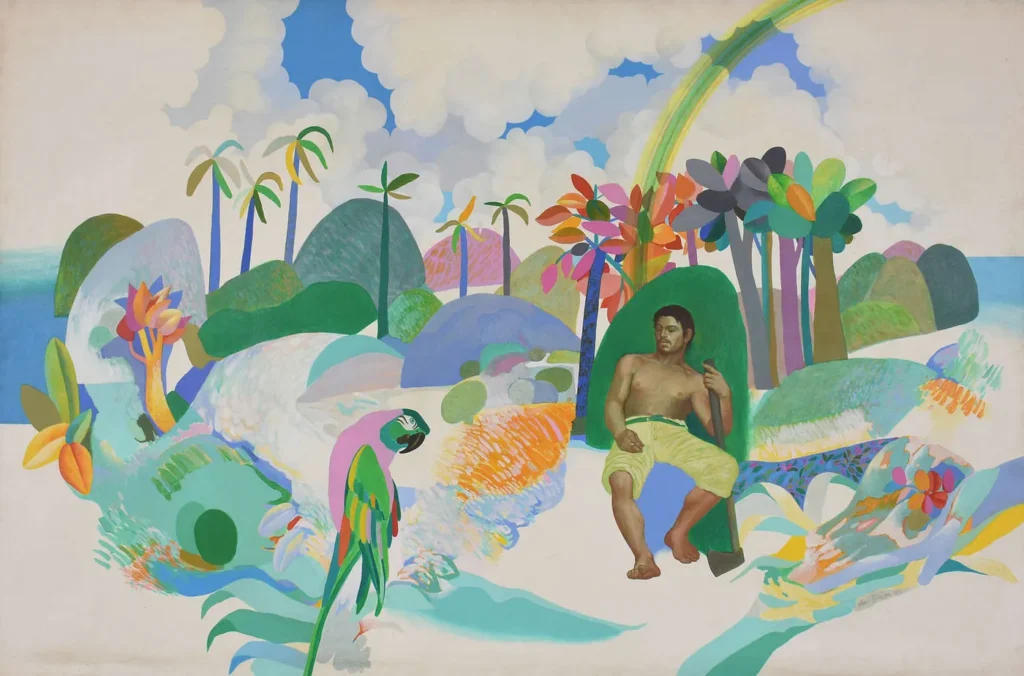
Ione Saldanha
Ione Saldanha (Alegrete, 1919 – Rio de Janeiro, 2001) was a painter and sculptor whose career, spanning almost six decades, stood out for its formal rigor and the consistency of her research. She began her production in the 1940s with figurative paintings of historic urban landscapes, far removed from the fast pace of modern metropolises, and then, starting in the 1950s, she immersed herself in abstraction. At the end of the 1960s, she expanded her investigation to three-dimensional supports, exploring above all the verticality of bamboo, slats, and spools, creating a unique visual vocabulary that synthesized elements of Brazilian architecture and popular culture.
In recent decades, her work has been widely rediscovered and celebrated in important institutions in Brazil and abroad. In 2021–2022, MASP dedicated a major retrospective to her, Ione Saldanha: A Cidade Inventada, bringing together around 200 works. In 2023, the artist was presented in dialogue with Etel Adnan at Casa Gerassi (Simões de Assis, São Paulo), and in 2024 she had her first solo exhibition in the United States, The Time and The Color, at Salon 94 Gallery in New York. That same year, her works were included in the main exhibition of the 60th Venice Biennale, as well as in the group show Paisagens Temporais at Almeida & Dale in São Paulo. In 2025, her relevance was reaffirmed with her participation in the 36th São Paulo Biennial, consolidating her as one of the most original voices in 20th-century Brazilian art. In 2022, Paulo Kuczynski presented, in its first participation at Art Basel Miami Beach, the work of Ione Saldanha in the project Volpi & Ione: The Brightness of Tempera, creating a dialogue that emphasized her artistic approach and mastery of the medium.
Her works are part of major public collections, notably the Gilberto Chateaubriand Collection, the João Sattamini Collection, and the Adolpho Leirner Collection in Brazil. They are also represented in leading institutions such as the Museum of Fine Arts, Houston, the Museu de Arte de São Paulo (MASP), the Museu de Arte Contemporânea da Universidade de São Paulo (MAC-USP), and the Museu de Arte Moderna de São Paulo (MAM-SP).
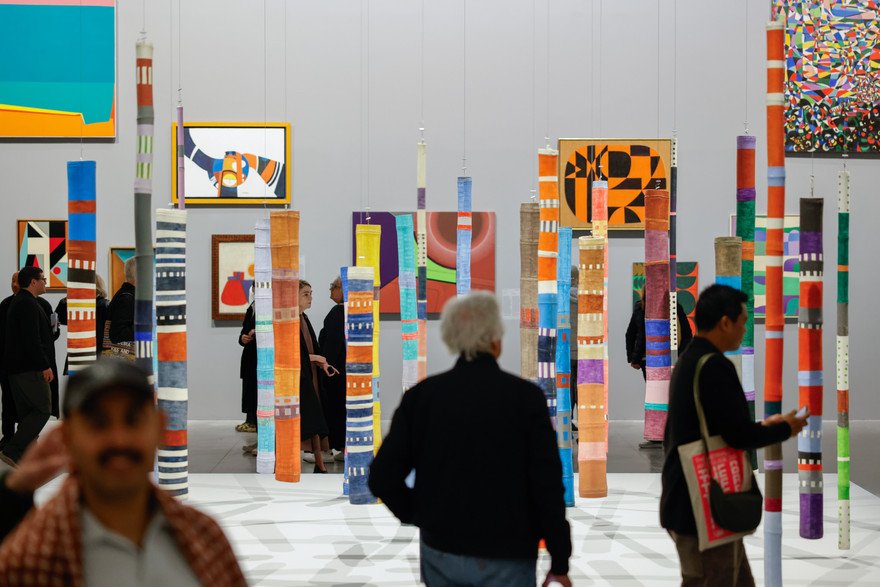
Afro-Brazilian Artists
Mestre Didi
Mestre Didi (Salvador, 1917–2013), born Deoscóredes Maximiliano dos Santos, was a sculptor, writer, researcher of the Yoruba language, and high priest of the Egungun ancestor cult. Son of Mãe Senhora, ialorixá of Ilê Axé Opô Afonjá, he devoted himself from an early age to Afro-Brazilian religions, traveling to West Africa, where he received the title of Alapini, and founding Ilê Asipá. His sculptural work, exhibited since the 1960s, recreates liturgical objects from Candomblé as autonomous works of art, using organic materials—palm ribs, wood, leather, straw, cowrie shells, seashells, seeds, always laden with religious symbolism. His pieces evoke Yoruba imagery, birds, snakes, spears, flames, and forces of nature, in constant dialogue with ancestry.
Among the exhibitions recently dedicated to his legacy, the following stand out: Um Deoscóredes: 100 anos do Alapini Deoscóredes Maximiliano dos Santos — Arte e Religiosidade at Museu Afro Brasileiro, São Paulo, 2017), which celebrated his centenary; Os Iniciados no Mistério Não Morrem at Instituto Inhotim, 2023–2024, with around 30 sculptures from his collection in dialogue with Yoruba ancestry; a solo exhibition at the James Cohan Gallery in New York in 2024, bringing together totemic sculptures made from natural materials; and Mestre Didi: Spiritual Form at El Museo del Barrio, New York, 2025, the artist’s first major exhibition in the United States in 25 years, with more than 30 works exploring his symbolic and spiritual language.
Mestre Didi’s works are also part of important public collections, including the Bass Museum of Art, Museu de Arte Moderna da Bahia, Museu de Arte Moderna de São Paulo, Museu de Arte de São Paulo Assis Chateaubriand, Pinacoteca de São Paulo, El Museo del Barrio, Itaú Cultural, and Museu Afro-Brasil.
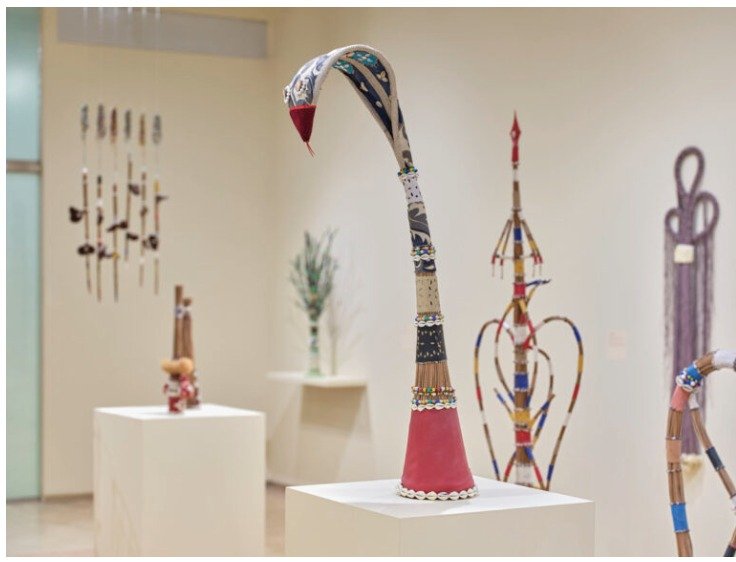
Nádia Taquary
Nádia Taquary (Salvador, 1967) is a sculptor and visual artist whose work channels African ancestral wisdom and affirms the protagonism of Black women. Using reclaimed wood, metals, beads, cowrie shells, and straw, she creates sculptures, installations, and videos that merge tradition and contemporaneity, transforming objects into carriers of memory, spirituality, and empowerment. Series such as Oríki, Dinkas Orixás, and the Yabás sculptures pay tribute to Yoruba culture and sacred feminine figures, evoking strength, resistance, and ancestral reverence. Through this practice, Taquary reclaims cultural space, challenges Eurocentric and patriarchal narratives, and celebrates Black women’s knowledge and heritage.
She has exhibited internationally, including solo shows such as ÔOnã Irin: Caminho de Ferro at MAR, Rio de Janeiro, 2023 and Museu Nacional da Cultura Afro-Brasileira, Salvador, and group exhibitions at Haus der Kulturen der Welt, Berlin, and El Museo del Barrio, New York. She participated in the 24th Sydney Biennale, 2024, the 15th Bienal de La Habana, 2025, and is featured in the 36th São Paulo Bienal, 2025. Other notable exhibitions include Red Atlantic in Geneva, 2024, Dos Brasis, São Paulo, Petrópolis, 2023–2024, and The Precious Life of a Liquid Heart, New York, 2023.
Nádia Taquary’s work is held in prominent public collections both in Brazil and internationally. Her pieces are part of the Museum of Modern Art of Bahia (MAM-BA) in Salvador, the Pinacoteca de São Paulo, the Rio Art Museum (MAR), and other major Brazilian institutions. Internationally, her work is included in the Pérez Art Museum Miami (PAMM), the Museum of Arts and Design (MAD) and the Institute for Studies on Latin American Art (ISLAA) in New York, as well as the Thyssen-Bornemisza National Museum, reflecting the global recognition and significance of her artistic practice.
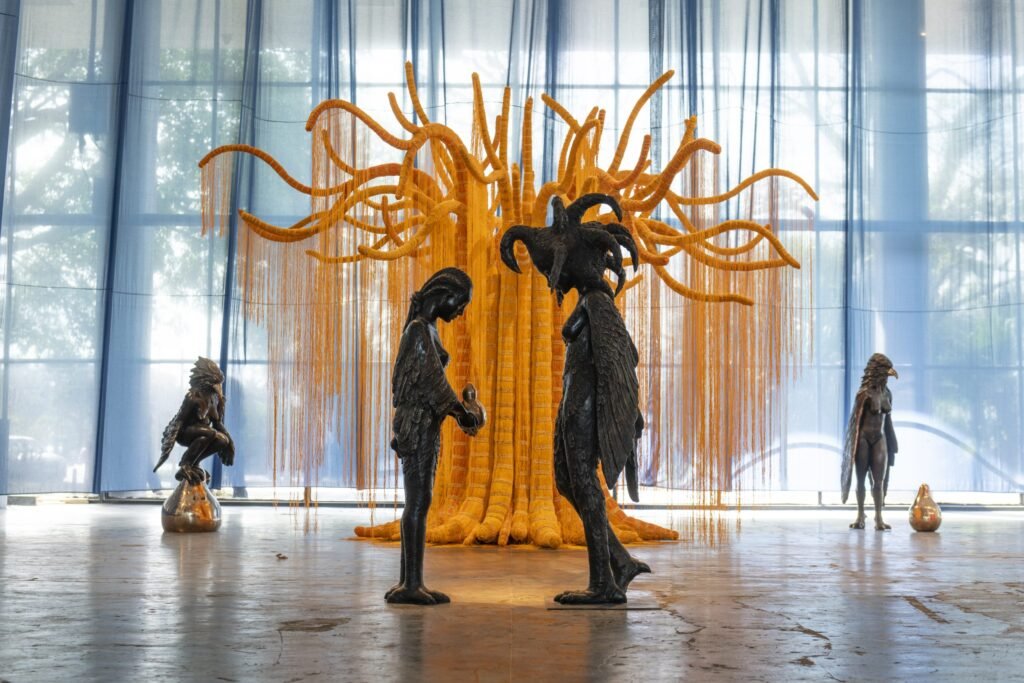
Maria Lira Marques
Maria Lira Marques (Araçuaí, 1945) is an artist, researcher, and cultural activist from the Vale do Jequitinhonha, Minas Gerais. From a young age, she became interested in ceramics, following the work of her mother Odília and other local artisans. Over the course of her career, she has developed a body of work that integrates natural pigments, clay, earthy tones, and sertanejo landscapes, including the Bichos do Sertão cycle — a vast bestiary of imaginary creatures inhabiting her imagination and the Vale’s territory. At the same time, she has played a crucial role in preserving and promoting local knowledge: alongside Frei Chico, she helped found the Araçuaí Museum in 2010 and led the Trovadores do Vale choir, dedicated to the region’s popular song traditions.
In recent years, Maria Lira Marques has gained unprecedented visibility in major institutions, with exhibitions showcasing her full career or presenting new works. Highlights include Maria Lira Marques – Roda dos Bichos at Instituto Tomie Ohtake, São Paulo, 2024, her first large-scale institutional exhibition, featuring paintings, sculptures, clay pieces from the hills of the Vale do Jequitinhonha, natural pigments, masks, painted stones, and elements of documentary record such as photographs, songs, and objects; her participation in the 38th Panorama da Arte Brasileira, 2024, presenting new works; and the Julia Isidrez & Maria Lira Marques exhibition at Galeria Gomide&Co, São Paulo, 2025, which established a dialogue between the two artists’ practices, with recent paintings and ceramics highlighting parallels in their traditions and cultural imaginaries. In addition, Galeria Gomide&Co, in partnership with Act. Editora, published her first monograph, Maria Lira, organized by Rodrigo Moura, consolidating her career and reinforcing the significance of her work within the contemporary Brazilian art scene.
Her works are part of public collections, notably: Inhotim Institute, in Brumadinho, Museum of Modern Art of São Paulo, Pontal Museum in Rio de Janeiro, Araçuaí Museum, in Minas Gerais, Pinacoteca of São Paulo and Nationalmuseet, in Copenhagen
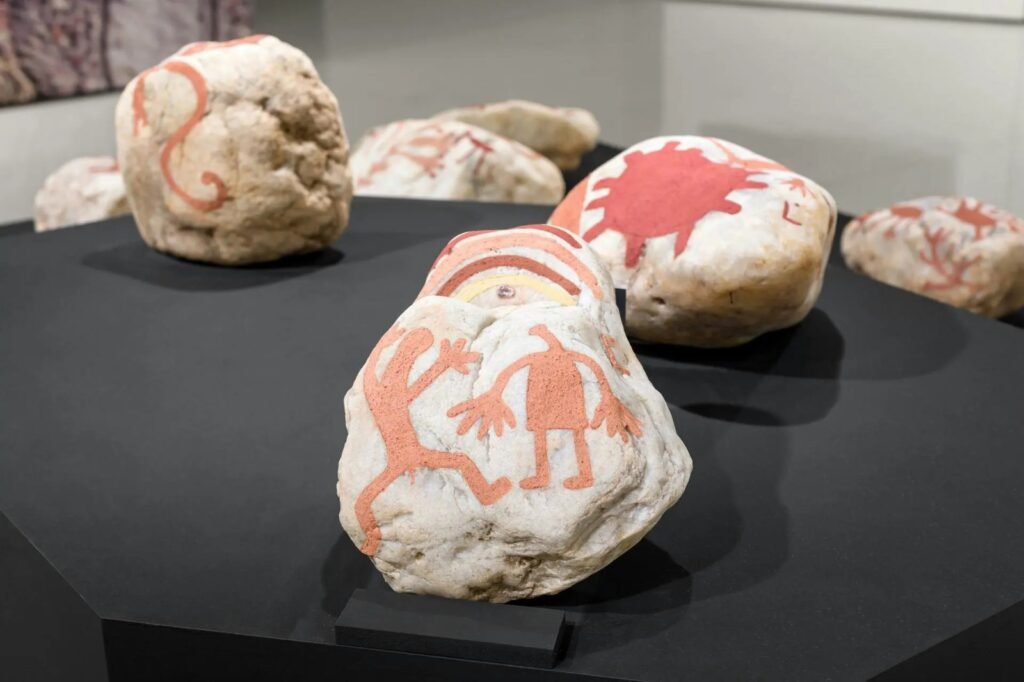
Crioula Jewelry
The exhibition presents a collection of 22 historical Crioula Jewels, crafted with the emblematic materials of 19th-century Bahian goldsmithing, gold, coral, horn, ivory, and precious stones, from the prestigious collection of Emmanoel Araújo. These masterpieces were worn by freed Black women, known as Crioulas, who had sometimes acquired their liberty through trade or domestic work. Ostentatious, precious, and imbued with Afro-Brazilian symbolism, the adornments constituted an act of visibility and social affirmation within a society deeply marked by racial hierarchy. They expressed not only economic achievement but also a claim to dignity. Some pieces maintained a close connection to Candomblé rituals and the representation of the orixás, underscoring the central role of Black women in the transmission of spiritual knowledge. Today, the contemporary use of Crioula Jewelry transforms objects once stigmatized as marks of slavery or resistance into symbols of pride and collective power, reaffirming their status as living archives and intangible heritage of Brazilian culture. They embody a collective memory inseparable from the struggle against slavery and from the Afro-Brazilian contribution to the shaping of national identity.
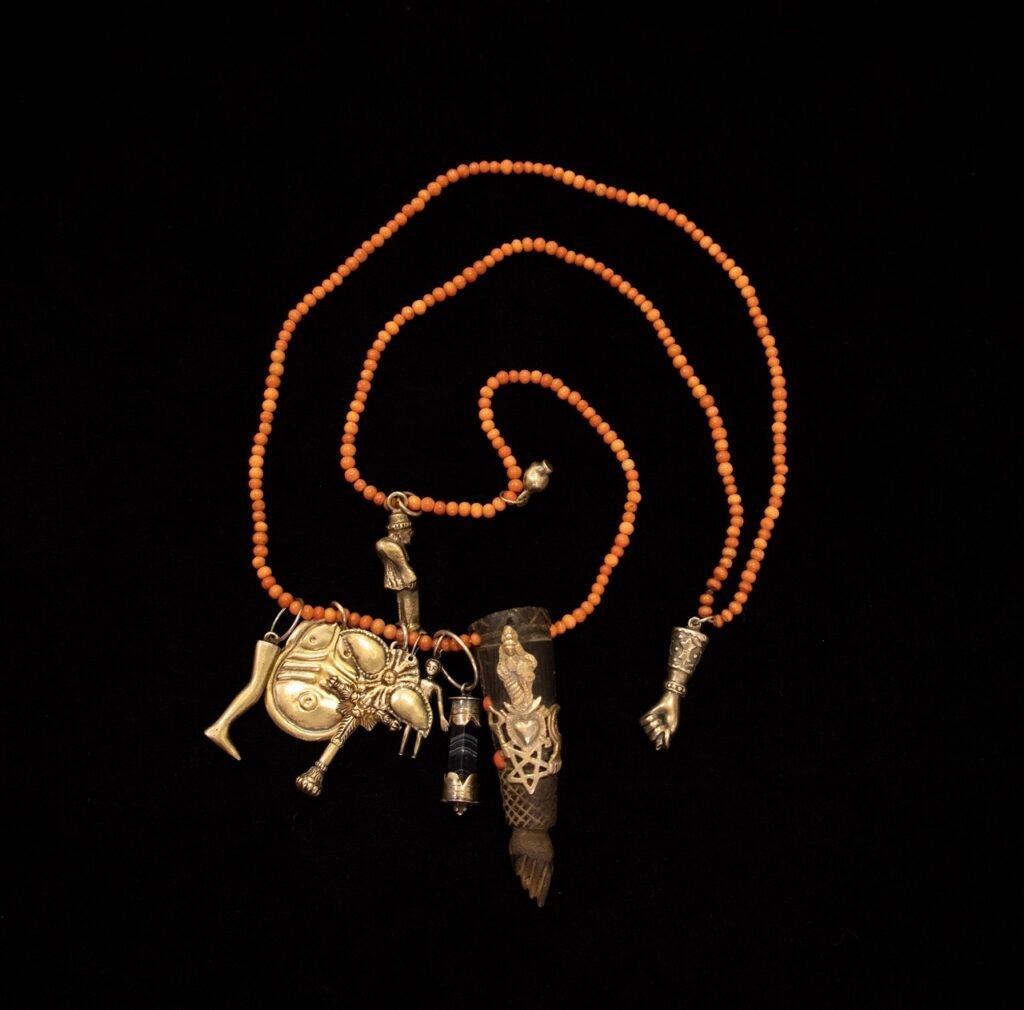
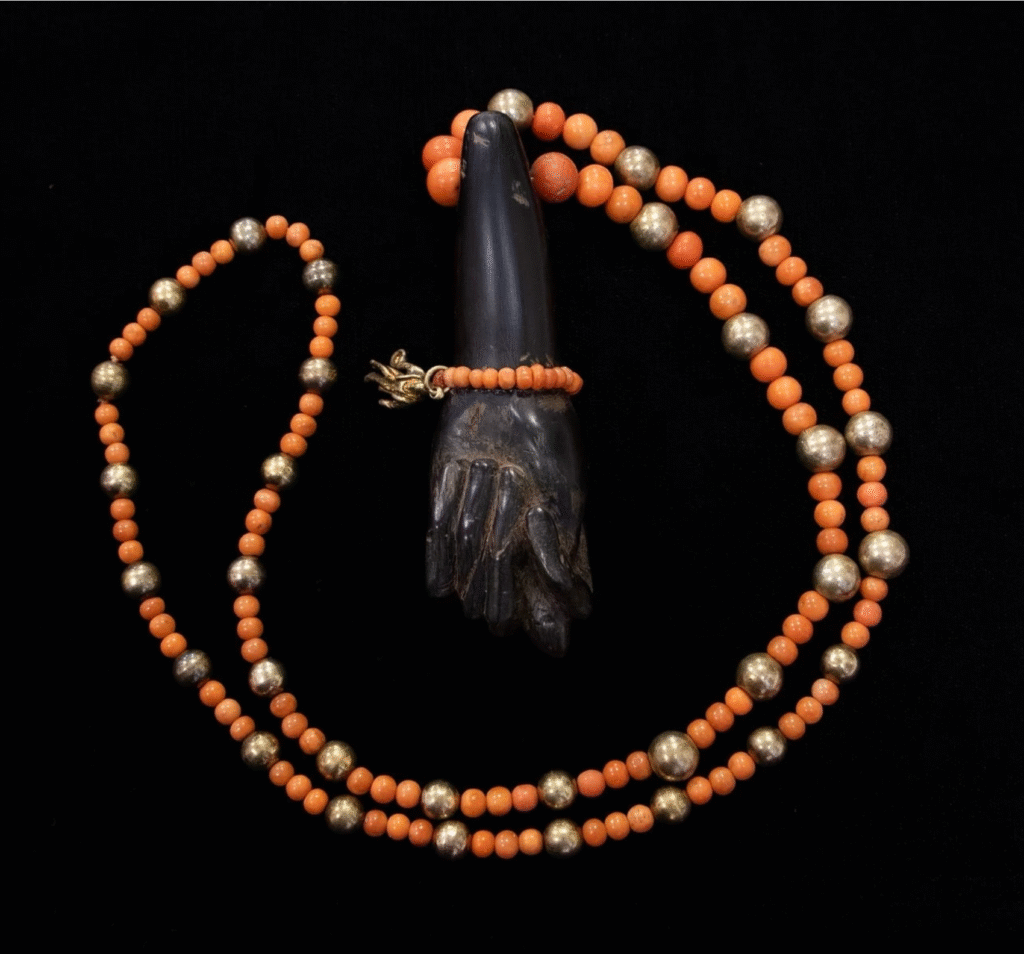
Indigenous Artists
Chico da Silva
Chico da Silva (1910, Alto Tejo, Acre – 1985, Fortaleza, Ceará) was born in the Amazon rainforest and moved with his family to Ceará as a child, settling in Fortaleza in 1935. He began painting the whitewashed walls of fishermen’s houses using charcoal, bricks, and leaves, before being discovered in 1943 by Swiss critic and artist Jean-Pierre Chabloz, who played a decisive role in projecting his work nationally and internationally. In his gouaches and paintings, da Silva depicted Amazonian fauna—birds, fish, and fantastical creatures such as dragons—drawing on the oral traditions of Northern Brazil. With his vivid palette, intricate graphic lines, and imaginative compositions, he established himself as a key figure of Brazilian popular art, with exhibitions in Brazil and Europe.
In 2023, the Pinacoteca de São Paulo presented the exhibition Chico da Silva and the Pirambu Studio, followed by the expanded version at the Pinacoteca do Ceará. That same year, the artist gained international recognition with a solo booth at Galatea’s Independent Fair in New York and opened his first major solo exhibition in the United States at the David Kordansky Gallery in New York, featuring approximately 25 paintings and works on paper from the 1960s and 1970s. In 2024, Galatea again featured the artist, this time in a solo booth at Frieze Masters in London.
During his lifetime, he enjoyed significant commercial success and attracted considerable critical attention. In recent years, his market has gained new strength: in 2023, he achieved his auction record with Serpente da serra luminosa, c.1966, sold at Sotheby’s New York for $330,200.
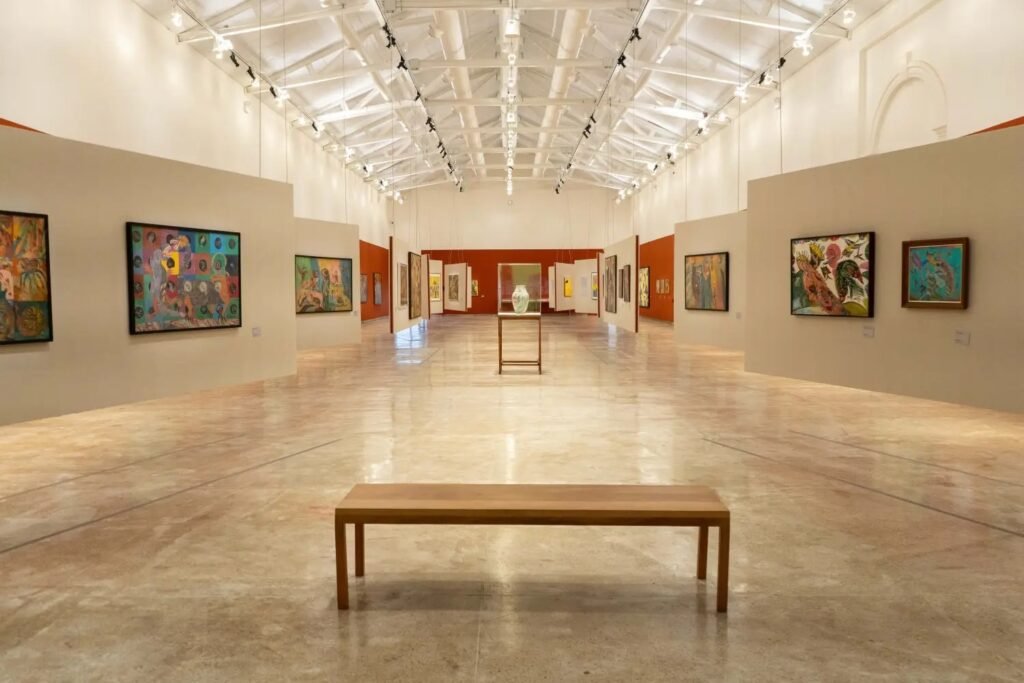
Jaider Esbell
Jaider Esbell (Normandia, RR, 1979 – São Paulo, 2021- Originating from the indigenous Makuxi people.) was an artist, writer, and cultural producer of the Makuxi people. Raised in the Raposa Serra do Sol Indigenous Territory, he initially worked as an electrician at Eletrobras, where he combined technical duties with environmental and sociocultural projects before dedicating himself fully to art. His work, marked by symbolic force, bridges Indigenous tradition and contemporary languages. Among his most emblematic creations are the Cosmic Snakes, monumental inflatable sculptures presented at the 34th São Paulo Biennial in 2021 and later installed on the façade of the Amazonas Theater in Manaus, 2023. The project evokes spirituality, fertility, and protection within Makuxi cosmology, bringing Indigenous art into the urban and institutional sphere. In 2022, Esbell also participated in the 59th Venice Biennale, consolidating his presence on the international stage.
Even after his untimely death, Jaider continues to be celebrated as one of Brazil’s greatest contemporary indigenous artists. In 2025, the Ministry of Culture awarded him posthumously the Knight of the Order of Cultural Merit, presented to his mother, D. Zenilda Sarmento, during the opening of the International Seminar “Traditional and Popular Cultures and Climate Justice – Global Dialogues and Local Knowledge” in Brasilia. In the same year, the Jaider Esbell Gallery of Contemporary Indigenous Art, founded as a collective and independent space for the production and circulation of indigenous artists, received the Brazilian Association of Art Critics (ABCA) Award, a recognition that reinforces the artist’s legacy to the history of Brazilian art.
Gladstone Gallery, New York, presented in 2025 the first U.S. exhibition of Jaider Esbell, showcasing paintings and drawings from his final years. The works highlight his distinctive use of black backgrounds, vibrant patterns, and references to Macuxi cosmology.
His works are part of major public collections, notably the Centre Georges Pompidou and the Fondation Cartier pour l’art contemporain in Paris, MALBA – Museo de Arte Latinoamericano de Buenos Aires, the Pinacoteca de São Paulo, and Instituto PIPA in Rio de Janeiro.
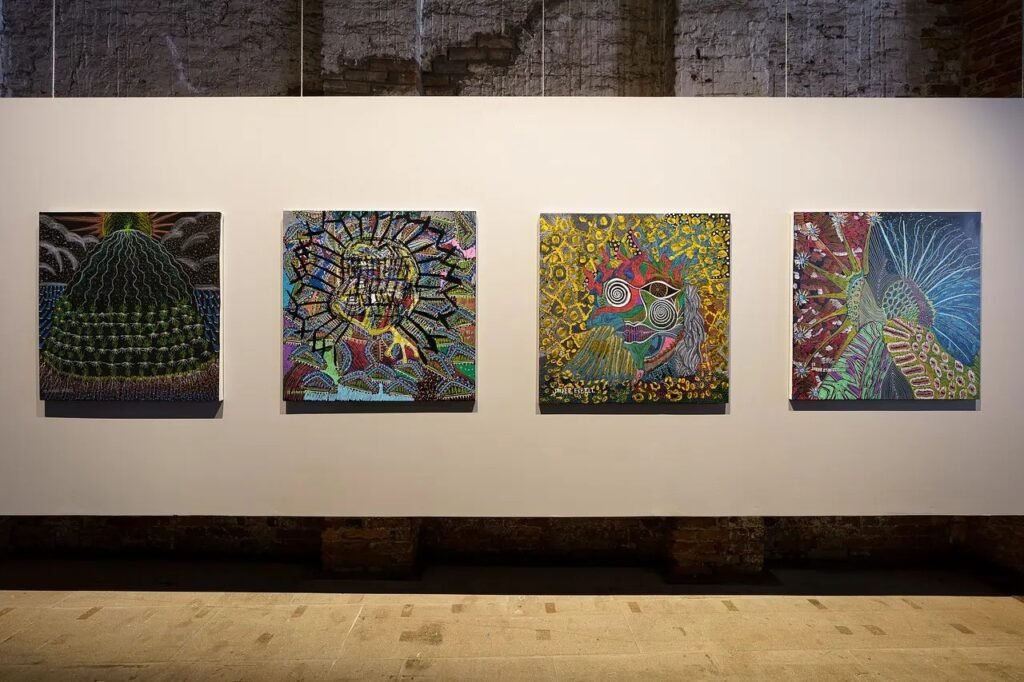
Aislan Pankararu
Aislan Pankararu (Petrolândia, Pernambuco, 1990 – Originating from the indigenous Pankararu people.) is an artist of the Pankararu people whose practice spans painting, installation, and sculpture. Trained as a doctor, he integrates Indigenous cosmology, natural observation, and scientific knowledge to create works that evoke healing, resistance, and vitality. His practice ranges from the monochrome of white clay, traditionally used in body painting, to vibrant compositions referencing the plants, roots, seeds, and flowers of the caatinga biome, while simultaneously materializing bodies, memories, and territories.
In recent years, the artist has gained recognition in both national and international institutions. He participated in the exhibition Histórias Indígenas at MASP, São Paulo, 2022, curated by Adriano Pedrosa in collaboration with Kode Bergen Art Museum (Norway), which traveled in 2024, marking a significant international milestone for contemporary Indigenous art. In 2023, he was part of Brasil Futuro: As Formas da Democracia, which toured the Museu Nacional da República (Brasília), Casa das Onze Janelas (Belém), and Solar do Ferrão (Salvador), bringing together artists whose works assert rights and identities in contexts of threat. In 2025, he presented his first solo exhibition in the United States, Endless River, at Salon 94 in New York, realized in collaboration with Galatea (São Paulo) and Alexandra Mollof Fine Art and was part of the 36th Sao Paulo Biennial.
His works are included in major collections, such as the Instituto Inhotim (Minas Gerais), and have been recognized for their ability to create visual systems that reconcile spirituality, science, tradition, and ecology. In his practice, painting and sculpture serve as fields of resistance, healing, and reclamation of space, projecting a contemporary Indigenous vision that engages with the global challenges of our time.
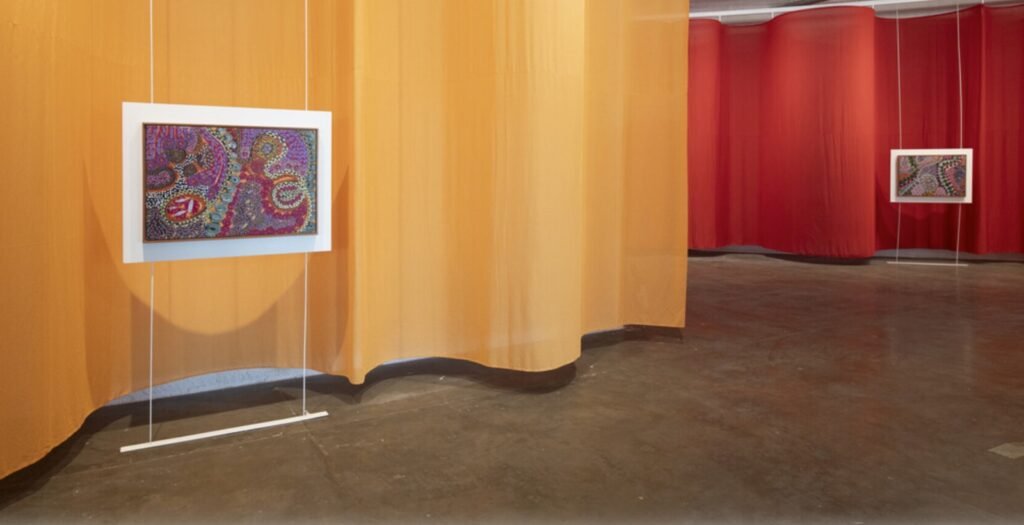
MAHKU
MAHKU – Movement of Huni Kuin Artists, (Karajá indigenous land, founded in 2013 – Originating from the Kaxinawá indigenous people.) and composed of Ibã Huni Kuin, Kássia Borges, Acelino Tuin, Cleiber Bane, Pedro Maná, Yaka Huni Kuin, Rita Huni Kuin, Cleudo Txana Tuin, and Isaka Huni Kuin, is based between the municipality of Jordão and the Chico Curumim village in the Kaxinawá (Huni Kuin) Indigenous Territory, Acre. The collective translates Huni Meka songs into visual form, drawn from nixi pae ayahuasca rituals, creating bridges between Indigenous and non-Indigenous worlds. Their paintings materialize visionary experiences that weave together mythical narratives, ancestral memory, and nature’s living entities, affirming art as a space of healing, spirituality, and cultural resistance.
MAHKU – Movement of Huni Kuin Artists, founded in 2013 and composed of Ibã Huni Kuin, Kássia Borges, Acelino Tuin, Cleiber Bane, Pedro Maná, Yaka Huni Kuin, Rita Huni Kuin, Cleudo Txana Tuin, and Isaka Huni Kuin, is based between the municipality of Jordão and the Chico Curumim village in the Kaxinawá Indigenous Territory, Acre. The collective translates Huni Meka songs into visual form drawn from nixi pae ayahuasca rituals, creating bridges between Indigenous and non-Indigenous worlds. Their paintings materialize visionary experiences that weave together mythical narratives, ancestral memory, and the living presence of nature, affirming art as a space of healing, spirituality, and cultural resistance. MAHKU has participated in exhibitions including Histoires de Voir at the Fondation Cartier in Paris, Mestizo Stories at the Tomie Ohtake Institute in São Paulo, the 35th Panorama of Brazilian Art – Brazil by Multiplication at MAM São Paulo, Vaivém at the Banco do Brasil Cultural Center in Brasília, Vexoá: we know at the Pinacoteca de São Paulo, and Avenida Paulista at MASP. Their works have carried out large-scale projects including murals in Belo Horizonte and Belém, as well as a commission for the Goeldi Museum in Pará, reinforcing the cultural and territorial autonomy of the Huni Kuin people.
With a unique iconography characterized by human and non-human figures integrated into graphic patterns inspired by Huni Kuin body paintings, MAHKU renounces Western perspective and proportion and dedicates himself exclusively to the forces of miração, visionary experiences stimulated by ayahuasca. The result is a spiritual, collective, and healing art that transforms mythical narratives into visual and sensory experiences.
The growing commodification of Indigenous artists’ work illustrates the challenges they face within an art market still shaped by colonial logics, perpetuating dynamics antithetical to equality. In contrast to this logic of absorption, the MAHKU collective does not limit itself to producing works for the market: through the initiative “Vender tela para comprar terra” (“Sell a Painting to Buy Land”), they redirect the proceeds of their art toward the repurchase of ancestral lands, transforming the artistic act into a tool of historical reparation and sovereignty.
The group is represented in important public collections, notably the Museu de Arte de São Paulo (MASP), the Pinacoteca do Estado de São Paulo, and the Fondation Cartier pour l’art contemporain in Paris.

Kássia Borges Karajá
Kássia Borges Karajá (Goiânia, 1962 – Originating from the Karajá indigenous people) is a visual artist, researcher, teacher, and curator. She lives and works in Uberlândia (MG), developing a body of work that dialogues with ancestry and issues related to the female universe. Inspired by the Karajá ceramic tradition, she uses clay as the main medium in her contemporary creations. In addition to her individual research, she is a member of the MAHKU collective (Movement of Huni Kuin Artists), which gained international recognition by participating in the 60th Venice Biennale in 2024.
In recent years, Kássia has been consolidating her presence in important institutions and art circuits. In 2023, she participated in the collective exhibition Histórias indígenas at MASP, a show that brought together productions by artists from different indigenous peoples to rethink narratives and expand the history of Brazilian art from an indigenous perspective. In 2025, she participated in the exhibition Fullgás – Visual Arts and the 1980s in Brazil, presented at the Centro Cultural Banco do Brasil (CCBB) in São Paulo, Rio de Janeiro, Brasília, and Belo Horizonte, which revisits the artistic scene of the 1980s and its reverberations in the present.
Her works are part of important public collections, notably the Museu de Arte Contemporânea de Goiânia, the Pinacoteca de São Paulo, and the Museu de Arte de São Paulo (MASP) and Musée du Quai Branly.
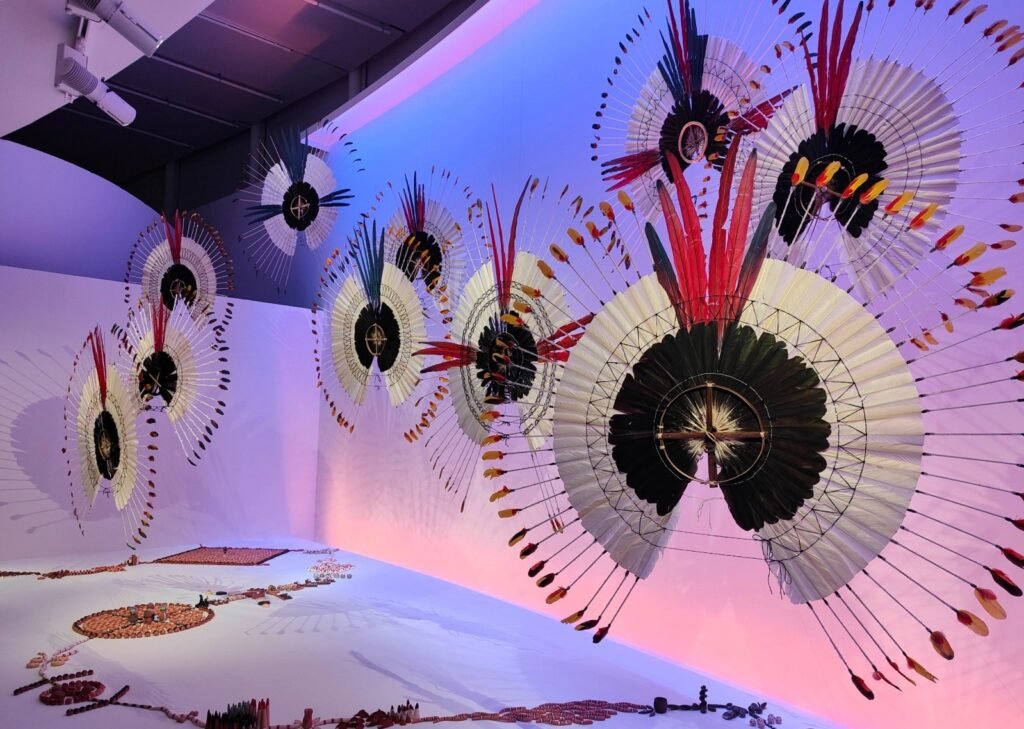
Denilson Baniwa
Denilson Baniwa (Alto Nego, Amazonas, 1984 – Originating from the Baniwa indigenous people) is an indigenous artist from the Baniwa people, born in Barcelos, in the interior of Amazonas, and currently residing in Niterói, Rio de Janeiro. His work combines art and activism, seeking to preserve and value indigenous cultures, while challenging colonial narratives and proposing new forms of knowledge and expression. Co-founder and coordinator of Rádio Yandê, an indigenous communication platform, Baniwa amplifies the voices and agendas of his people, addressing issues such as territorial rights, culture, and politics. His work on the radio reflects a commitment to a critical and innovative editorial line, focused on indigenous peoples. For Baniwa, being indigenous and being an artist are inseparable dimensions of his practice. His indigenous identity leads him to invent his own ways of making art, in which imagination and creation become interventions on the history of the colonization of indigenous territories in Brazil and invitations to reflect on collective responsibilities.
In recent years, Denilson Baniwa has presented his work at important institutions and art spaces, consolidating his position in the contemporary scene. In 2023, he participated in the 35th São Paulo Biennial, as well as in Moqueca de Maridos at the A Gentil Carioca gallery in São Paulo, and Corpo Botânico at the Victor Brecheret Pavilion in Catacumba Park in Rio de Janeiro, as well as Escola Panapaná at the Pinacoteca de São Paulo, marking dialogues with education, nature, and ancestry. In 2024, her work was exhibited internationally in Under the Skin of History at the Princeton University Art Museum in the United States, expanding the visibility of her research on art, memory, and indigenous territories. Most recently, in 2025, he takes part as commissioner and project manager of the exhibition Amazon: Indigenous Creations and Futures at the Musée du Quai Branly – Jacques Chirac, in Paris (on view until January 18, 2026), bringing indigenous perspectives into dialogue with so-called “ethnographic” collections and contemporary art.
His works are part of important public collections, notably the Museu de Arte Contemporânea da Universidade de São Paulo (MAC-USP), the Denver Art Museum (DAM), Instituto Inhotim, the Pérez Art Museum Miami (PAMM), and the Princeton University Art Museum. They are also represented in the Museo Nacional Centro de Arte Reina Sofía in Madrid, the Pinacoteca do Estado de São Paulo, and the Instituto Itaú Cultural in Brazil.
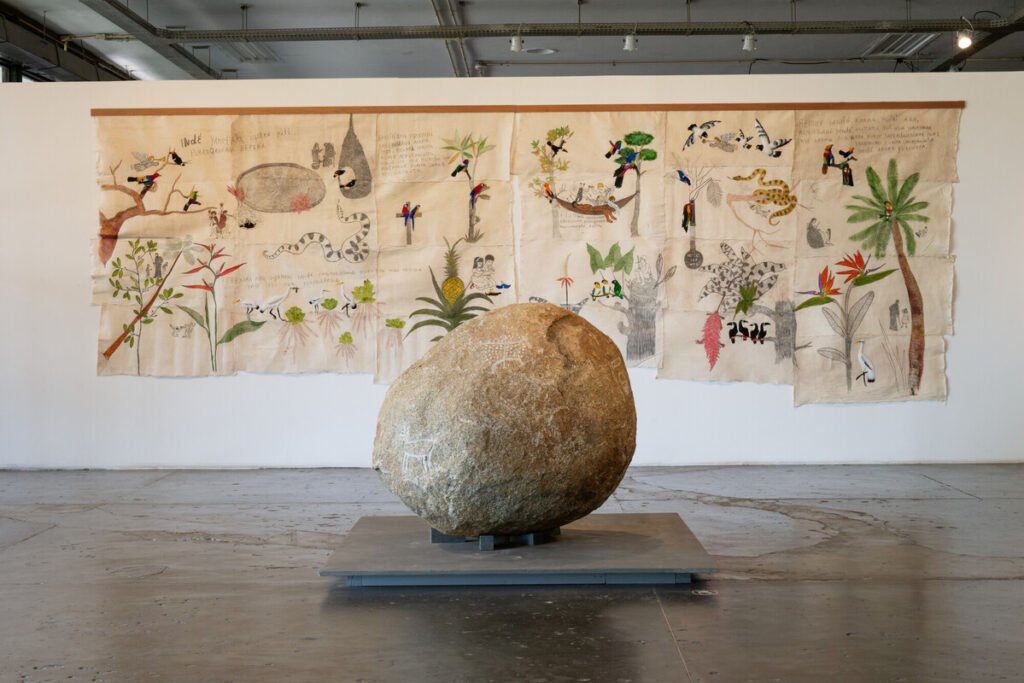
Tropical Surrealism
Bruno Novelli
Bruno Novelli (Fortaleza, 1980) grew up in Porto Alegre, and currently lives and works in São Paulo. His work focuses mainly on painting. He began his art studies in 2003 at the Ateliê Livre da Prefeitura de Porto Alegre (Porto Alegre City Hall Free Studio) and completed a degree in Graphic Design in 2014 at ESPM in São Paulo. In the early years of his career in Porto Alegre, he founded (between 2003 and 2007) the Universidade Autoindicada por Entidades Livres (Self-Nominated University by Free Entities), a series of meetings and collective art programs that fostered interdisciplinary approaches.
Strongly inspired by the exuberance of the Amazonian world and nurturing a long-standing dialogue with Huni Kuin indigenous artists, Novelli creates paintings featuring fantastic animals, dreamlike visions of nature, and an intense color palette. His work draws on diverse traditions, from the bestiary of medieval painting, through the Renaissance, what was mistakenly called “naïve art,” surrealism, and pop art, to construct an unmistakable style. There is also a critical tension in this work between the European view of the tropical landscape and the ways in which man dominates nature.
In 2021, he held the solo exhibition Tesouro das Feras (Treasure of the Beasts) at the Museum of Contemporary Art of Rio Grande do Sul, in Porto Alegre, in addition to participating in the group exhibition 1981/2021: Brazilian contemporary art in the collection of Andrea and José Olympio Pereira, at the CCBB in Rio de Janeiro. The following year, in 2022, he was part of the exhibition Les Vivants, organized by the Fondation Cartier pour l’art contemporain in Lille, France. In 2023, he participated in the group exhibition Siamo Foresta, presented by the Fondation Cartier at the Triennale di Milano, Italy. In 2024, he had his largest solo exhibition to date, Tudo se Transforma na Terra, at Galatea, in São Paulo, featuring large-format paintings never before seen. Also in 2024, his works were included in the group exhibition Narciso, a belleza refletida, at Farol Santander, in São Paulo, dedicated to self-portraits in modern and contemporary Brazilian art. The artist already has two upcoming exhibitions scheduled for next year, at the Museu Oscar Niemeyer in Curitiba and at the Pinacoteca de São Paulo.
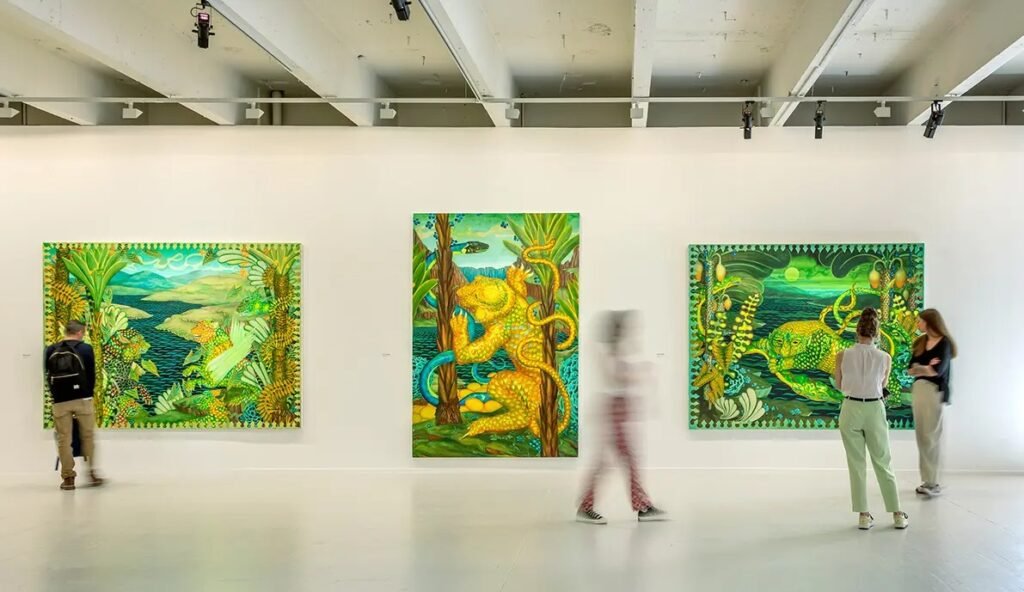
Critical Coloniality
Adriana Varejão
Adriana Varejão is an artist whose work is openly political, constantly engaging with Brazil’s colonial and post-colonial history. Her cultural repertoire spans from Brazilian Baroque to 18th-century travel literature, allowing her to explore a confluence of ideas that reflect on the mythical pluralism of Brazilian identity. From the Baroque, Varejão draws on artificiality, trompe-l’oeil, and anamorphosis, employing strategies of simulation and juxtaposition to deceive the senses. Her interest in tiles and their legacy as a metaphor for cultural miscegenation is a central theme throughout her work. Varejão’s paintings achieve remarkable volumetric density, thanks to her meticulous attention to varying thicknesses, cracks, cuts, and crevices in the surfaces, which extend beyond the plane and occupy physical space.
Considered one of the most internationally acclaimed contemporary Brazilian artists, Varejão is currently represented by Gagosian. She held her first solo exhibition at the Stedelijk Museum, Amsterdam, and at the Calouste Gulbenkian Foundation, Lisbon. Her work is permanently on view at the pavilion of Instituto Inhotim, in Brumadinho. In 2022, she presented Suturas, Fissuras, Ruínas at the Pinacoteca de São Paulo. More recently, in 2025, she opened a sequence of three major international exhibitions: Adriana Varejão: Don’t Forget, We Come From the Tropics at The Hispanic Society Museum & Library in New York; Adriana Varejão and Paula Rego Monteiro at the Gulbenkian Center for Modern Art in Lisbon, where her works were shown alongside those of Paula Rego; and Adriana Varejão: Histórias Moldadas at Gagosian, Athens.
Her works are included in major public collections worldwide, including Bouwfonds Kunststichting, Hoevelaken (Netherlands); Centro de Arte Contemporânea Inhotim, Brumadinho, MG (Brazil); Culturgest, Lisbon (Portugal); Fondation Cartier pour l’Art Contemporain, Paris (France); Fundación La Caixa, Barcelona (Spain); Ghent Museum, Ghent (Belgium); Guggenheim Museum, New York (USA); Hara Museum of Contemporary Art, Tokyo (Japan); Museu de Arte Contemporânea de San Diego, San Diego (USA); Museu de Arte Moderna do Rio de Janeiro, Rio de Janeiro, RJ (Brazil); Museu de Arte Moderna de Sintra, Sintra (Portugal); Stedelijk Museum Amsterdam, Amsterdam (Netherlands); and Tate Modern, London (UK).
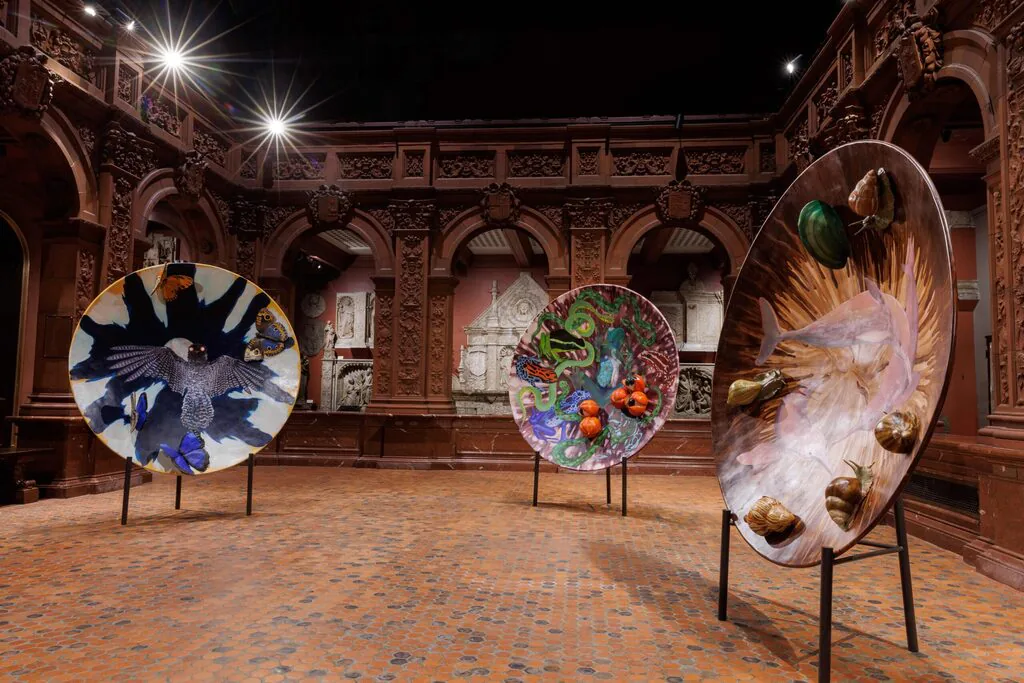
Brazilian artists are no longer just regional voices, they are now essential references on the global stage. Their consistent presence at leading fairs such as Art Basel, Frieze, and TEFAF, the growing number of Brazilian galleries in international circuits, and strong auction results are accompanied by acquisitions from world-class institutions. This confluence of market performance and institutional recognition underscores the momentum and long-term value of Brazilian art, positioning it as a key focus for discerning collectors worldwide.
At Sophie Su Art Advisory, we specialize in identifying, evaluating, acquiring, and selling works that matter. Our expertise ensures privileged access and strategic guidance for those seeking to expand or consolidate their collections with Brazilian art. Contact us via WhatsApp to explore opportunities, and don’t miss our exclusive preview of Cosmogonias Brasileiras.
Exhibition information
Cosmogonias Brasileiras
Galerie Natalie Seroussi
34, rue de Seine, Paris 6ᵉ
Opening: October 4, 2025 – On view until January 10, 2025
